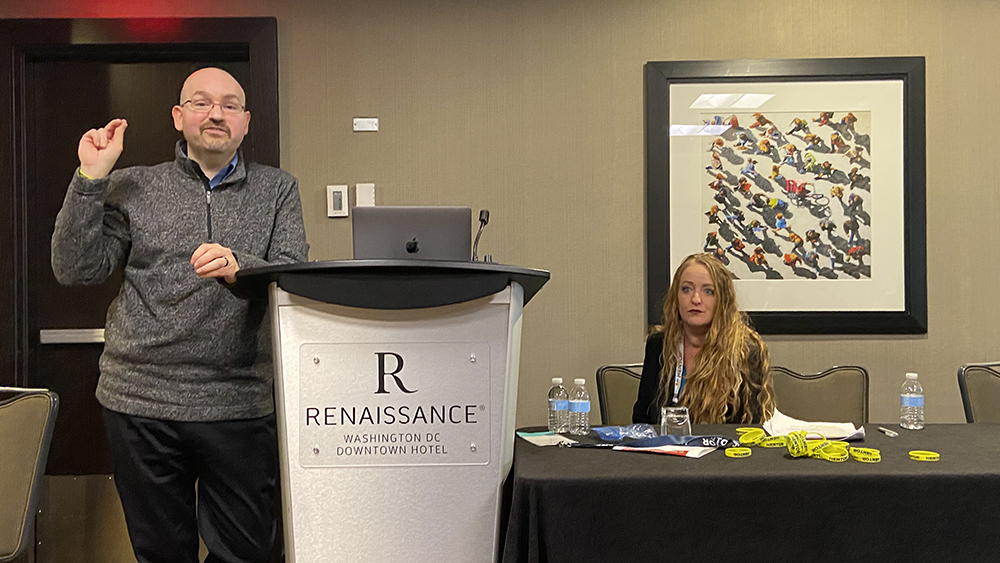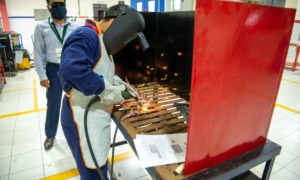
Chris Hultquist (at podium), executive director of The Mentor Connector, and Bobbi Jo Stellato, program director at The Mentor Connector, presenting at the 2020 National Mentoring Summit in Washington. | Allison Stevens
WASHINGTON — What can youth advocates in rural New England learn about reducing teen drug and alcohol use from a small island nation just below the Arctic Circle?
Quite a lot, according to Chris Hultquist, executive director of a youth mentoring organization in Vermont — a state reeling from the opioid epidemic. He and other youth advocates there recently launched the Vermont Youth Project, a pilot program inspired by an Icelandic initiative that addresses the “causes of the causes” of adolescent substance use.
Two decades ago, the Nordic nation decided to move teen substance use prevention and treatment efforts away from a traditional focus on individual behavior change and toward addressing the societal and environmental factors that underlie the problem. Key components include enhancing extracurricular activities for youth and increasing the amount of time parents spend with kids and the degree to which they monitor their leisure time.
The shift was remarkably successful.
In 1998, the prevalence of teen substance use in Iceland was higher than most other European countries, according to a recent journal article about the program. That year, four in 10 high school sophomores in Iceland reported getting drunk within the past month, and roughly two in 10 said they were daily smokers and had tried cannabis, surveys showed.
“We had the worst youth in the world,” quipped Jon Sigfusson, director of the Icelandic Center for Social Research and Analysis.
Twenty years later, fewer than 10% of Iceland’s high school sophomores said they had gotten drunk in the past 30 days, smoked on a daily basis or had tried cannabis. The country now ranks among the lowest in adolescent substance use in Europe, and rates of bullying and youth theft have also plummeted, according to the Vermont Youth Project.
“Although it may not always seem likely, prevention is possible,” researchers affiliated with the program concluded — and they’re now working to export the model around the globe.
Vermont needed help
Hultquist sees potential in Vermont, a rural state with a higher per capita rate of opioid-involved deaths than the national average. Despite its renowned ski industry, it also struggles with poverty, youth who have been separated from parents, gang activity, trafficking and other social ills.
The opioid epidemic hit hard in Rutland County in the southern part of Vermont, home of Hultquist’s The Mentor Connector and “ground zero” in the state’s drug crisis. What’s more, six in 10 youth in the region have experienced some form of violence, and one in seven made a suicide plan last year, according to The Mentor Connector.
A survey taken last fall found that Vermont youth use substances at relatively high rates, have a lot of unorganized free time, lack access to structured activities after school and have relatively poor communication with parents. Many youth had family members who were using and abusing substances, Hultquist said.
“We had to do something about it,” he said during a presentation at a national mentoring conference in Washington last week. “We took a step back [and asked], ‘What if we change the norms of our community? Would that make a change?’”
The answer, he and other Vermonters agreed, was yes.
Today, the Vermont Youth Project — led by Vermont Afterschool and the Mentor Connector — is implementing the Icelandic Prevention Model at several sites throughout the state. The five-year program aims to boost extracurricular engagement among youth, help kids feel safe in and out of school and strengthen bonds between youth and caring adults.
After-school activities crucial
Mentoring for youth and families is a key part of the program. Mentored youth are less likely to use alcohol or drugs, have higher self-esteem and are more likely to hold leadership positions, according to the Mentor Connector. Eighty-five percent of youth who have participated in mentoring said it helped them refrain from drugs.
Good matches are essential to success, according to Bobbi Jo Stellato, program director at The Mentor Connector. “We want long-term community impact,” she told the audience at the mentoring conference. “We’re in the relationship business. We realized that connecting with the families, building that rapport from the beginning, was super important.”
At the community level, the program aims to connect youth to after-school and out-of-school programs that emphasize art, music, sports, horseback riding and other interests. The goal is to ensure that all youth are connected to some activity outside school, which proponents say builds participants’ sense of belonging and strengthens their social connections.
“The mentor is really that catalyst for that out-of-school support for the youth,” Hultquist said.
If the pilot program is successful, Hultquist hopes it eventually expands to more sites in the state and the country.
It already has support in high places.
Last year, researchers briefed state lawmakers about the model, and last month Gov. Phil Scott endorsed it in his annual State of the State address.
“I propose to you today that we begin creating a universal afterschool network that ensures every child has access to enrichment opportunities outside of current classroom time,” he said. “The evidence is clear: Kids who participate in afterschool activities and programs do better in school and in life than kids who don’t.”





























